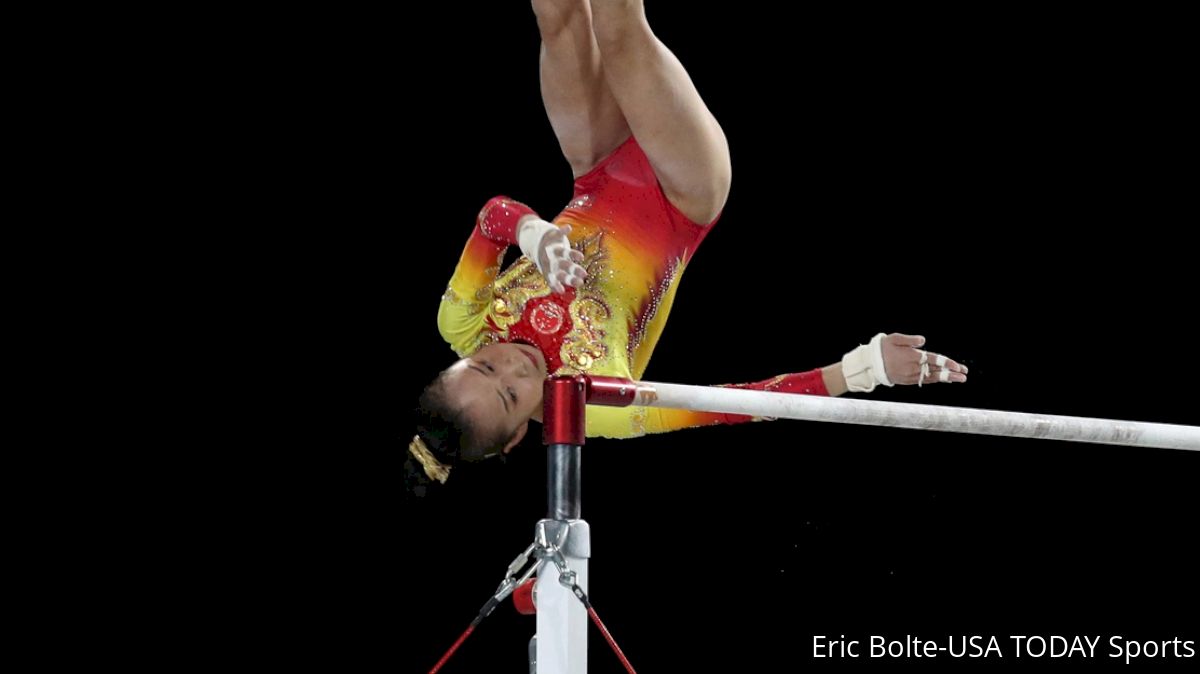What's The Difference: Deltchev, Gienger, Comaneci, Markelov, Shushunova
What's The Difference: Deltchev, Gienger, Comaneci, Markelov, Shushunova
This group of uneven bar release skills, all done on the high bar, aren’t quite a family, but all look somewhat similar.

We’ve already covered the differences between the Shaposhnikova skills and the Tkatchev family, two major categories of uneven bars release moves. But there’s a whole other rag-tag group of release skills, all done on the high bar, that aren’t quite a family, but all look somewhat similar—and, in these modern gymnastics days, are all somewhat rare. Here’s how to tell the difference between a Deltchev, Gienger, Comaneci, Markelov and Shushunova—because when you actually see one, you’ll want to know what you’re looking at.
Deltchev
Difficulty: D
The Deltchev, named for the male gymnast Stoyal Deltchev of Bulgaria, looks like a weird cross between a Gienger (below) and a straddled Jaeger. It starts with the gymnast in a swing facing outward from the bar, and as she comes up on the other side, she does a half turn into a front flip with her legs straddled and catches the bar on the other side. It has the same outwards → inwards motion of a Gienger, but a different type of flip.
Gienger
Difficulty: D (piked) or E (layout)
Unlike a Deltchev, which is a half turn into a front flip, a Gienger is a backflip into a half turn; both start in a swing facing outwards and end facing inwards, but the order of the twist/flip is reversed. The skill is named for the male German gymnast Eberhard Gienger, who first performed the skill. It can be done in a piked position or a layout position, with the pike at a D and the layout with an E (though many of the layout versions end up looking pretty piked anyways). These days, you’ll see some gymnasts connect one of the Shaposhnikova skills with a half twist into a Gienger to get some extra connection points.
Comaneci
Difficulty Value: E
The Comaneci is named for famous Russian gymnast Nadia Comaneci, who competed the first Comaneci in the 1976 Olympic Games—the same Olympics where she got her perfect 10s. To do a Comaneci, the gymnast looks like she’s doing a cast to a handstand, but instead does a front flip with her legs in a straddle position, catching the bar in a hang on the same side as where she started. Although the Comenci has a high difficulty value, it’s particularly tough to connect anything into or out of it—which means that many of today’s gymnasts prefer to train other E skills that can get them those extra bonus connection points.
Markelov
Difficulty Value: D
The Markelov is another skill named for a male gymnast—this time, Vladimir Markelov of the Soviet Union. (The skill is also sometimes referred to as Khorkina, named for female gymnast Svetlana Khorkina of Russia.) It begins with a front giant facing outwards, and as the gymnast reaches the top of the bar, she flies over it and does half twist with her legs in a straddle, and then catches the bar on the other side.
Shushunova
Difficulty Value: E
Soviet gymnast Elena Shushunova first competed the original Shushunova at the 1986 World Cup. The skill is essentially a Markelov with an extra half twist; instead of starting in a front-giant swing facing outwards, the gymnast does a long swing facing inwards, and as she nears the top of her arc, she does a half twist, travels over the high bar in a straddled position, does another half twist, and then catches the bar on the other side.
Brette Warshaw is a freelance writer and consultant based in New York City. You can follow her at @bstarwarshaw.